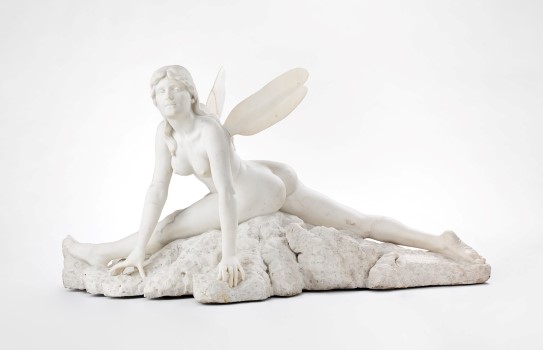Papillon
Menga Shjelderup-Ebbe
Transcription
Narrator:
What does it take to make a sculpture out of marble, that luminous rock that can portray hair, eyelashes, nails, the skin creases on the bottom of a foot, the folds in a piece of cloth? How is this done?
Håkon Anton Fagerås is a sculptor and stone carver. His studio is in an old mill outside Oslo, next to a waterfall.
Håkon Anton Fagerås:
A marble sculpture almost always starts off in clay. You begin by modelling in clay, which allows you to add and subtract, right until the sculpture looks exactly as you want.
You can’t do that with stone.
Then you cast it in plaster, because clay falls apart if you just leave it standing around, and then you use the plaster model as your starting point for carving in stone.
What I do, when I’m going to carve in stone, or what a stone carver does when they’re going to carve for an artist, is to use a pointing machine to take measurements. You take reference points from the plaster model, transfer them to the stone and then carve according to the points. On very many marble sculptures, if you look closely, you’ll see some small dots here and there on the surface, some small indentations that haven’t been carved away. These are remnants of the pointing process.
Narrator:
Now look at her. She is Papillon, by Menga Schjelderup-Ebbe: graceful, flexible, strong and nonchalant. Wings as light as air, like an elf. Or a butterfly. She appears almost weightless, but in fact she is extremely heavy.
Håkon Anton Fagerås:
It may sound a bit strange, but it’s easier to get marble to look soft — despite marble being a hard material – than it is to get clay to look soft, despite clay being a soft material.
That’s because there isn’t enough resistance in clay. But with marble, which is hard enough, you encounter so much resistance and you have to go over it again and again and work on the transitional areas, and the softness is found in the transitions between shapes. And another thing with marble is that it has very, very small crystals, in contrast to granite, for example, which is used very often for carving Norwegian stone sculptures, and that allows you to work in fractions of a millimetre. And softness demands that level of precision.
Narrator:
Menga Schjelderup-Ebbe, one of the few women sculptors of her time, did not carve her sculptures herself, but sent her plaster models to a professional stone carver. He was called Carpanini and may have come from Carrara in Italy. The craftsmen in these Italian marble quarries were among the best in the world – and they still are today.
Håkon Anton Fagerås:
Nearly all artists have their sculptures carved for them; there are very few artists who carve themselves. It’s a separate discipline that takes a very long time to learn, and your production will also be extremely limited if you carve everything yourself.
For me, it’s very important to carve things myself, because of the enjoyment of the work and pride in the result, once it’s finished.